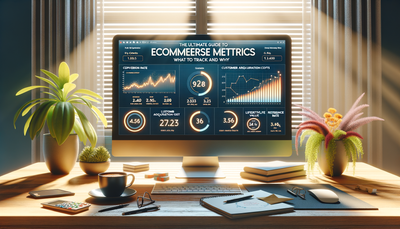Creating a Resources Page for Your B2B Business Website
A well-crafted resources page can be a powerful tool for B2B businesses, providing value to potential clients and establishing your company as an industry authority. This comprehensive guide explores the process of creating an effective resources section for your B2B website. We'll delve into the various types of resources you should consider including, strategies for organizing your content, and how to leverage gated content for lead generation. By implementing these best practices, you can transform your resources page into a valuable asset that not only informs and educates your audience but also drives conversions and builds lasting relationships with potential clients.Table of Contents:

Types of Resources to Include
When developing your B2B resources page, it's essential to offer a diverse range of content that caters to different learning styles and information needs. Consider including the following types of resources:1. White papers and e-books: In-depth, research-based documents that provide comprehensive insights on industry topics.
2. Case studies: Real-world examples of how your products or services have solved problems for other businesses.
3. Webinars and video tutorials: Visual content that demonstrates your expertise and explains complex concepts.
4. Infographics: Visual representations of data and information that are easy to digest and share.
5. Blog posts and articles: Regular updates on industry trends, best practices, and thought leadership pieces.
6. Templates and tools: Downloadable resources that help potential clients streamline their processes.
7. FAQs and glossaries: Quick reference guides to industry-specific terms and common questions.
By offering a variety of resource types, you'll appeal to a broader audience and showcase your company's expertise across multiple formats.
Do you need a website? Want to build a website but don't know where to start? Our website builder is the perfect solution. Easy to use, and with the ability to customize to fit your business needs, you can have a professional website in no time.
Organizing Your Resources Page
An well-organized resources page is crucial for user experience and navigation. Consider these strategies for structuring your content:1. Categorization: Group similar resources together under clear, descriptive categories (e.g., Industry Insights, How-To Guides, Case Studies).
2. Search functionality: Implement a robust search feature to help users quickly find relevant content.
3. Filtering options: Allow users to filter resources by type, topic, or industry vertical.
4. Featured content: Highlight your most popular or timely resources at the top of the page.
5. Clear descriptions: Provide brief summaries of each resource to help users understand its content and value.
6. Consistent layout: Use a uniform design for resource listings to create a cohesive look and feel.
7. Mobile optimization: Ensure your resources page is responsive and easy to navigate on all devices.
By implementing these organizational strategies, you'll create a user-friendly resources page that encourages exploration and engagement with your content.
Leveraging Gated Content for Lead Generation
Gated content can be an effective lead generation tool for B2B businesses. Here's how to implement it effectively:1. Choose high-value content: Reserve gating for your most in-depth, valuable resources that justify the exchange of contact information.
2. Create compelling landing pages: Design informative, persuasive landing pages that clearly communicate the value of your gated content.
3. Use progressive profiling: Gradually collect more information about leads over time, rather than asking for everything upfront.
4. Offer a mix of gated and ungated content: Maintain a balance to provide value to all visitors while still generating leads.
5. Implement lead scoring: Assign point values to different content interactions to identify your most engaged prospects.
6. Follow up promptly: Have a system in place to quickly follow up with leads who download your gated content.
7. Analyze and optimize: Regularly review your gated content performance and adjust your strategy based on the data.
By strategically using gated content, you can generate high-quality leads while providing valuable resources to your target audience.
Building a website with SITE123 is easy
Promoting Your Resources Page
Creating great content is only half the battle; you also need to promote your resources page effectively. Consider these promotion strategies:1. Internal linking: Include links to your resources page throughout your website, especially in relevant blog posts and service pages.
2. Email marketing: Highlight new resources in your email newsletters and nurture campaigns.
3. Social media sharing: Regularly share individual resources and promote your resources page on your social media channels.
4. SEO optimization: Optimize your resources page and individual resource pages for relevant keywords to improve organic search visibility.
5. Paid advertising: Use targeted PPC campaigns to drive traffic to high-value gated content.
6. Partner promotion: Collaborate with industry partners to cross-promote each other's resources.
7. Employee advocacy: Encourage your team to share company resources on their professional social media profiles.
By actively promoting your resources page, you'll increase its visibility and maximize its potential for lead generation and brand authority building.
Measuring Success and Iterating
To ensure your resources page is meeting its objectives, it's crucial to measure its performance and make data-driven improvements. Consider tracking the following metrics:1. Page views and unique visitors: Monitor overall traffic to your resources page.
2. Time on page: Assess how engaged visitors are with your content.
3. Download/conversion rates: Track how many visitors are accessing your resources, especially gated content.
4. Lead quality: Evaluate the quality of leads generated through your resources page.
5. Resource popularity: Identify which types of content are most popular with your audience.
6. User feedback: Collect and analyze user feedback to understand what content is most valuable.
7. SEO performance: Monitor organic search rankings and traffic for resource-related keywords.
Use these insights to continually refine your resources page, updating content, adjusting your gating strategy, and improving the user experience. Regular iteration based on data and user feedback will help you maximize the value of your resources page for both your audience and your business.





